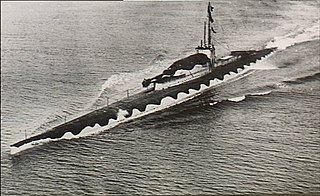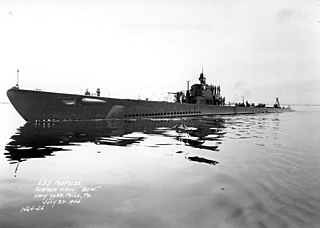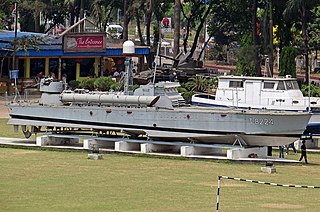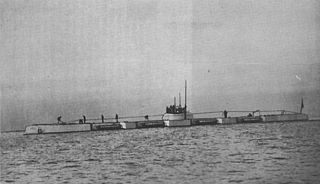
In naval terminology, a destroyer is a fast, maneuverable, long-endurance warship intended to escort larger vessels in a fleet, convoy, or carrier battle group and defend them against a wide range of general threats. They were originally conceived in 1885 by Fernando Villaamil for the Spanish Navy as a defense against torpedo boats, and by the time of the Russo-Japanese War in 1904, these "torpedo boat destroyers" (TBDs) were "large, swift, and powerfully armed torpedo boats designed to destroy other torpedo boats". Although the term "destroyer" had been used interchangeably with "TBD" and "torpedo boat destroyer" by navies since 1892, the term "torpedo boat destroyer" had been generally shortened to simply "destroyer" by nearly all navies by the First World War.

Ilmarinen was a Finnish Navy Panssarilaiva, Swedish Pansarskepp. The unit was constructed at the Crichton-Vulcan shipyard in Turku, Finland, and named after the mythological hero Ilmarinen from the Finnish national epic, the Kalevala. Ilmarinen was the flagship of the Navy from 1 May 1933 until her sinking on 13 September 1941.

The V-boats were a group of nine United States Navy submarines built between World War I and World War II from 1921 to 1934 under authorization as the "fleet boat" program.

The Akula class, Soviet designation Project 971 Shchuka-B is a series of fourth generation nuclear-powered attack submarines (SSNs) first deployed by the Soviet Navy in 1986. There are four sub-classes or flights of Shchuka-B, consisting of the original seven Project 971 boats, commissioned between 1984 and 1990; six Project 971Is, commissioned between 1991 and 2009; one Project 971U, commissioned in 1995; and one Project 971M, commissioned in 2001. The Russians call all of the submarines Shchuka-B, regardless of modifications.

The British Royal Navy M-class submarines were a small class of diesel-electric submarines built during World War I. The unique feature of the class design was a 12-inch (305 mm) gun mounted in a casemate forward of the conning tower.

The Royal Navy's T class of diesel-electric submarines was designed in the 1930s to replace the O, P, and R classes. Fifty-three members of the class were built just before and during the Second World War, where they played a major role in the Royal Navy's submarine operations. Four boats in service with the Royal Netherlands Navy were known as the Zwaardvisch class.

The United States Navy Salmon-class submarines were an important developmental step in the design of the "fleet submarine" concept during the 1930s. An incremental improvement over the previous Porpoise class, they were the first US submarine class to achieve 21 knots with a reliable propulsion plant, allowing them to operate with the Standard-type battleships of the surface fleet. Also, their 11,000 nautical miles (20,000 km) unrefueled range would allow them to operate in Japanese home waters. These rugged and dependable boats provided yeoman service during World War II, along with their immediate successors, the similar Sargo class. In some references, the Salmons and Sargos are called the "New S Class", 1st and 2nd Groups.

The Porpoise class were submarines built for the United States Navy in the late 1930s, and incorporated a number of modern features that would make them the basis for subsequent Salmon, Sargo, Tambor, Gato, Balao, and Tench classes. In some references, the Porpoises are called the "P" class.

The United States' S-class submarines, often simply called S-boats, were the first class of submarines with a significant number built to United States Navy designs. They made up the bulk of the USN submarine service in the interwar years and could be found in every theater of operations. While not considered fleet submarines, they were the first submarines in the USN designed for open ocean, blue water operations. All previous submarines had been intended for harbor or coastal defense. These boats were intended to have greater speed and range than previous classes, with improved habitability and greater armament.

The British L-class submarine was originally planned under the emergency war programme as an improved version of the British E-class submarine. The scale of change allowed the L class to become a separate class.

The S-class or Srednyaya submarines were part of the Soviet Navy's underwater fleet during World War II. Unofficially nicknamed Stalinets, boats of this class were the most successful and achieved the most significant victories among all Soviet submarines. In all, they sank 82,770 gross register tons (GRT) of merchant shipping and seven warships, which accounts for about one-third of all tonnage sunk by Soviet submarines during the war.

The P 4-class torpedo boat, Soviet designations Project 123-bis and Project 123-K, commonly called the Komsomolets class, were Soviet aluminum-hulled torpedo boats. They were armed with twin heavy machine guns and two 450 mm (17.7 in) torpedoes. A large number of them were exported to allied states such as North Vietnam and China. They saw service in a variety of conflicts including World War II, the First Taiwan Strait Crisis, the Vietnam War and the Turkish Invasion of Cyprus.

The Dekabrist class, also known as Series I, were the first class of submarines built for the Soviet Navy after the October Revolution of 1917. They were authorized in the Soviet Naval Shipbuilding Program of 1926, marking the revival of submarine design in Russia. They were authorized in the Soviet Naval Shipbuilding Program of 1926, and began their sea trials in 1930.

The Morzh-class submarines were built for the Black Sea Fleet of the Imperial Russian Navy shortly before World War I.

The Ronis-class submarines were built for the Latvian Navy in France in 1925. They were acquired by the Soviets in 1940 following the annexation of Latvia by the Soviet Union. They were scuttled in Liepāja in June 1941 as the Germans were about to capture the port. The hulls were raised in 1942 and scrapped.

The G-5 was a Soviet motor torpedo boat design built before and during World War II. Approximately 300 were built, of which 73 were lost during the war. Four were exported to the Spanish Republican Navy during the Spanish Civil War and others were transferred to North Korea after the war. Three were captured by the Finns, but only two were used before all three had to be returned to the Soviets after the Moscow Armistice in 1944.

Russian submarine Bars ("Leopard") was a warship, the lead submarine of her class, built for the Imperial Russian Navy during the First World War. She was active in the Baltic and was lost there in 1917.

The Russian submarine Tyulen was the third and last boat in the Morzh class of submarines of the Imperial Russian Navy. It was laid down in August 1913 and was launched in November 1913, though it did not enter service until March 1915. Built for the Black Sea Fleet, it saw action during World War I and became the most successful Russian submarine in the Black Sea, credited with sinking over 40 ships for a total tonnage of 8,973 gross register tons (GRT). It was also the second most successful Russian submarine in the war overall, after Volk.

The Russian submarine Morzh was the lead ship of the Morzh class of submarines of the Imperial Russian Navy. The submarine was laid down in August 1913 and was launched in September 1913, though it was not completed until April 1915.

The Russian submarine Nerpa was the second boat of the Morzh-class of submarines of the Imperial Russian Navy. It was laid down and launched on the same day in August 1913, and completed its sea trials in December 1914. Built for the Black Sea Fleet, the submarine saw action during World War I, and spent much of the war raiding Ottoman merchant shipping that transported coal from Zonguldak to Constantinople. Nerpa was credited with sinking 24 ships during the conflict for a total of 2,443 gross register tons (GRT), making it the fourth most successful Russian submarine in the Black Sea.
























